Nortel Networks 1140E User Manual

Nortel Communication Server 1000
IP Phone 1140E
User Guide

Revision history
Revision history
June 2009
Standard 03.02. This document is up-issued to support Nortel Communications Server 1000 Release 6.0.
May 2009
Standard 03.01. This document is up-issued to support Nortel Communications Server 1000 Release 6.0.
January 2009
Standard 02.05. This document is up-issued to support Nortel Communications Server 1000 Release 5.5 for UNIStim 3.0. This document reflects changes in section Enabling USB Headset.
December 2008
Standard 02.04. This document is up-issued to support Nortel Communications Server 1000 Release 5.5 for UNIStim 3.0. This document reflects changes in sections Setting up a conference call and Charging a call or charging a forced call.
April 2008
Standard 02.03. This document is up-issued to support Nortel Communications Server 1000 Release 5.5 for UNIStim 3.0.
May 2007
Standard 01.01. This document is up-issued to support
CS 1000 Release 5.0. This document reflects the new document number.
November 2006
Standard 5.00. This document is up-issued to reflect an update to Regulatory information.
3

Revision history
June 2006
Standard 4.00. This document is issued to support
Nortel Communication Server 1000 Release 4.5 software. Added support for new security features.
February 2006
Standard 3.00. This document is issued to support
Nortel Communication Server 1000 Release 4.5 software.
January 2006
Standard 2.00. This document is issued to support
Nortel Communication Server 1000 Release 4.5 software.
November 2005
Standard 1.00. This document is issued to support
Nortel Communication Server 1000 Release 4.5 software.
4

Contents
Contents
About the Nortel IP Phone 1140E . . . . . . . . . . . . . . . . . . . . 11
Basic features . . . . . . . . . . . . . . . . . . . . . . . . . . . . . . . . . . . . . 11
Telephone controls . . . . . . . . . . . . . . . . . . . . . . . . . . . . . . . . . 14
Telephone display . . . . . . . . . . . . . . . . . . . . . . . . . . . . . . . . . |
20 |
Call features and Flexible Feature Codes . . . . . . . . . . . . . . . 20
Security features . . . . . . . . . . . . . . . . . . . . . . . . . . . . . . . . . . . 21 Using encrypted calling . . . . . . . . . . . . . . . . . . . . . . . . . . 21 Managing your Station Control Password (SCPW) . . . . . 21
Entering and editing text . . . . . . . . . . . . . . . . . . . . . . . . . . . 24
Entering text using the IP phone dialpad . . . . . . . . . . . . . . . . 24 Entering text using the USB keyboard . . . . . . . . . . . . . . . . . . 25 Editing text using the soft keys . . . . . . . . . . . . . . . . . . . . . . . . 25
Connecting the components . . . . . . . . . . . . . . . . . . . . . . . . 27
Before you begin . . . . . . . . . . . . . . . . . . . . . . . . . . . . . . . . . . 28 Connecting the components of the phone . . . . . . . . . . . . . . . 28
Configuring Telephone Options . . . . . . . . . . . . . . . . . . . . . 34
Using the Telephone Options menu . . . . . . . . . . . . . . . . . . . . 35 Adjusting the volume . . . . . . . . . . . . . . . . . . . . . . . . . . . . 36 Adjusting the display screen contrast . . . . . . . . . . . . . . . . 37 Selecting a language . . . . . . . . . . . . . . . . . . . . . . . . . . . . 38 Selecting date and time format . . . . . . . . . . . . . . . . . . . . 39 Accessing display diagnostics . . . . . . . . . . . . . . . . . . . . . 40 Choosing a local dialpad tone . . . . . . . . . . . . . . . . . . . . . 40 Viewing IP Phone information . . . . . . . . . . . . . . . . . . . . . 41 Diagnostics . . . . . . . . . . . . . . . . . . . . . . . . . . . . . . . . . . . . 42 Configuring call log options . . . . . . . . . . . . . . . . . . . . . . . 43 Choosing a ring type . . . . . . . . . . . . . . . . . . . . . . . . . . . . 47
5

Contents |
|
Enabling or disabling Call Timer . . . . . . . . . . . . . . . . . . . |
48 |
Enabling OnHook Default Path . . . . . . . . . . . . . . . . . . . . |
49 |
Changing feature key labels . . . . . . . . . . . . . . . . . . . . . . . |
49 |
Configuring the name display format . . . . . . . . . . . . . . . . |
51 |
Configuring Live Dialpad . . . . . . . . . . . . . . . . . . . . . . . . . |
52 |
Configuring Caller ID display order . . . . . . . . . . . . . . . . . |
53 |
Configuring Normal mode indication . . . . . . . . . . . . . . . . |
53 |
Configuring Local Menu options . . . . . . . . . . . . . . . . . . . . |
55 |
Using the 1. Preferences submenu . . . . . . . . . . . . . . . . . . . . |
57 |
Changing 1. Display Settings . . . . . . . . . . . . . . . . . . . . . . |
57 |
Changing 2. Language . . . . . . . . . . . . . . . . . . . . . . . . . . . |
58 |
Configuring 3. Headsets . . . . . . . . . . . . . . . . . . . . . . . . . . |
59 |
Configuring 4. Bluetooth . . . . . . . . . . . . . . . . . . . . . . . . . . |
66 |
Using the 2. Local Diagnostics submenu . . . . . . . . . . . . . . . . 78 Using 1. IP Set&DHCP Information . . . . . . . . . . . . . . . . . 78 Using 2. Network Diagnostic Tools . . . . . . . . . . . . . . . . . 78 Using 3. Ethernet Statistics . . . . . . . . . . . . . . . . . . . . . . . 78 Using 4. IP Network Statistics . . . . . . . . . . . . . . . . . . . . . 78 Using 5. USB Devices . . . . . . . . . . . . . . . . . . . . . . . . . . . 79
Using the 3. Network Configuration menu . . . . . . . . . . . . . . . 79
Using the 4. Lock Menu . . . . . . . . . . . . . . . . . . . . . . . . . . . . . |
79 |
Making a call . . . . . . . . . . . . . . . . . . . . . . . . . . . . . . . . . . . . . 80
Using Off-hook dialing . . . . . . . . . . . . . . . . . . . . . . . . . . . . . . |
80 |
Using On-hook dialing . . . . . . . . . . . . . . . . . . . . . . . . . . . . . . |
81 |
Using handsfree dialing . . . . . . . . . . . . . . . . . . . . . . . . . . . . . |
82 |
Using the Directory applications . . . . . . . . . . . . . . . . . . . . . . . 84 Making a call using the Corporate Directory . . . . . . . . . . 84 Making a call using the Personal Directory . . . . . . . . . . . 85 Making a call using the Callers List . . . . . . . . . . . . . . . . . 86 Making a call using the Redial List . . . . . . . . . . . . . . . . . . 87
6

Contents
Using Predial . . . . . . . . . . . . . . . . . . . . . . . . . . . . . . . . . . . . . 87 Using AutoDial . . . . . . . . . . . . . . . . . . . . . . . . . . . . . . . . . . . . 88 Using Ring Again . . . . . . . . . . . . . . . . . . . . . . . . . . . . . . . . . . 90 Using Last Number Redial . . . . . . . . . . . . . . . . . . . . . . . . . . . 91 Using Speed Call . . . . . . . . . . . . . . . . . . . . . . . . . . . . . . . . . . 91 Using System Speed Call . . . . . . . . . . . . . . . . . . . . . . . . . . . . 93 Using HotLine . . . . . . . . . . . . . . . . . . . . . . . . . . . . . . . . . . . . . 93 Using intercom calling . . . . . . . . . . . . . . . . . . . . . . . . . . . . . . 93
Answering a call . . . . . . . . . . . . . . . . . . . . . . . . . . . . . . . . . . 95 While on an active call . . . . . . . . . . . . . . . . . . . . . . . . . . . . . 96
Placing a call on hold . . . . . . . . . . . . . . . . . . . . . . . . . . . . . . . 96 Transferring a call . . . . . . . . . . . . . . . . . . . . . . . . . . . . . . . . . . 97 Using Timed Reminder Recall . . . . . . . . . . . . . . . . . . . . . . . . 98 Using Attendant Recall . . . . . . . . . . . . . . . . . . . . . . . . . . . . . . 99 Using Call Park . . . . . . . . . . . . . . . . . . . . . . . . . . . . . . . . . . . . 99 Recording a Calling Party Number . . . . . . . . . . . . . . . . . . . . 102 Displaying incoming calls . . . . . . . . . . . . . . . . . . . . . . . . . . . 102 Tracing a malicious call . . . . . . . . . . . . . . . . . . . . . . . . . . . . 103
Incoming calls . . . . . . . . . . . . . . . . . . . . . . . . . . . . . . . . . . . 104
Using Automatic Answerback . . . . . . . . . . . . . . . . . . . . . . . . 104
Using Call Pickup . . . . . . . . . . . . . . . . . . . . . . . . . . . . . . . . . 104
Using Call Waiting . . . . . . . . . . . . . . . . . . . . . . . . . . . . . . . . 106
While away from your desk . . . . . . . . . . . . . . . . . . . . . . . . 108
Using Call Forward . . . . . . . . . . . . . . . . . . . . . . . . . . . . . . . . 108 Using Internal Call Forward . . . . . . . . . . . . . . . . . . . . . . . . . 109 Using Remote Call Forward . . . . . . . . . . . . . . . . . . . . . . . . . 110 Securing your IP Phone . . . . . . . . . . . . . . . . . . . . . . . . . . . . 112
7

Contents
Talking with more than one person . . . . . . . . . . . . . . . . . 114
Using the Call Join feature . . . . . . . . . . . . . . . . . . . . . . . . . . 114 Setting up a conference call . . . . . . . . . . . . . . . . . . . . . . . . . 114 Using Conferee Selectable Display . . . . . . . . . . . . . . . . . . . 116 Using Group Call . . . . . . . . . . . . . . . . . . . . . . . . . . . . . . . . . 117
Working without interruption . . . . . . . . . . . . . . . . . . . . . . 120
Using Make Set Busy . . . . . . . . . . . . . . . . . . . . . . . . . . . . . . 120
Additional call features . . . . . . . . . . . . . . . . . . . . . . . . . . . |
121 |
Using AutoDial Transfer . . . . . . . . . . . . . . . . . . . . . . . . . . . . 121 Using the Buzz signal . . . . . . . . . . . . . . . . . . . . . . . . . . . . . . 122 Using Call Page Connect to make an announcement . . . . . 122 Using Centrex/Exchange Line Switchhook Flash . . . . . . . . . 123 Charging a call or charging a forced call . . . . . . . . . . . . . . . 124 Using Enhanced Override . . . . . . . . . . . . . . . . . . . . . . . . . . 127 Using Forced Camp-on feature . . . . . . . . . . . . . . . . . . . . . . 128 Overriding a busy signal . . . . . . . . . . . . . . . . . . . . . . . . . . . . 129 Using Privacy Release . . . . . . . . . . . . . . . . . . . . . . . . . . . . . 130 Using Radio Page . . . . . . . . . . . . . . . . . . . . . . . . . . . . . . . . . 130 Using Voice Call . . . . . . . . . . . . . . . . . . . . . . . . . . . . . . . . . . 132
Additional phone features . . . . . . . . . . . . . . . . . . . . . . . . . 134
Using the Personal Directory . . . . . . . . . . . . . . . . . . . . . . . . |
134 |
Using the Callers List . . . . . . . . . . . . . . . . . . . . . . . . . . . . . . |
137 |
Using the Redial List . . . . . . . . . . . . . . . . . . . . . . . . . . . . . . . 139
Using Virtual Office . . . . . . . . . . . . . . . . . . . . . . . . . . . . . . . . 141 Logging in to Virtual Office . . . . . . . . . . . . . . . . . . . . . . . 142 Using Virtual Office on your Remote IP Phone . . . . . . . 143 Using Virtual Office on your Office IP Phone . . . . . . . . . 145 Logging out of Virtual Office . . . . . . . . . . . . . . . . . . . . . . 147
8

Contents
Troubleshooting Virtual Office . . . . . . . . . . . . . . . . . . . . 148
Using Media Gateway 1000B . . . . . . . . . . . . . . . . . . . . . . . . 150
Using Test Local Mode . . . . . . . . . . . . . . . . . . . . . . . . . 151
Using Resume Normal Mode . . . . . . . . . . . . . . . . . . . . . 151
Troubleshooting MG 1000B . . . . . . . . . . . . . . . . . . . . . . 152
Using Hospitality features . . . . . . . . . . . . . . . . . . . . . . . . . 153
Configuring Automatic Wake-Up . . . . . . . . . . . . . . . . . . . . . 153
Activating Message Registration . . . . . . . . . . . . . . . . . . . . . 155
Using Maid Identification . . . . . . . . . . . . . . . . . . . . . . . . . . . 156
Displaying Room Status . . . . . . . . . . . . . . . . . . . . . . . . . . . . 157
Accessing External Server Applications . . . . . . . . . . . . . 160 Flexible Feature Codes (FFCs) . . . . . . . . . . . . . . . . . . . . . 161 Regulatory and safety information . . . . . . . . . . . . . . . . . . 163
Other . . . . . . . . . . . . . . . . . . . . . . . . . . . . . . . . . . . . . . . . . . . 166 DenAn regulatory notice for Japan . . . . . . . . . . . . . . . . . . . . 167
Terms you should know . . . . . . . . . . . . . . . . . . . . . . . . . . |
169 |
Index . . . . . . . . . . . . . . . . . . . . . . . . . . . . . . . . . . . . . . . . . . |
173 |
9

Contents
10
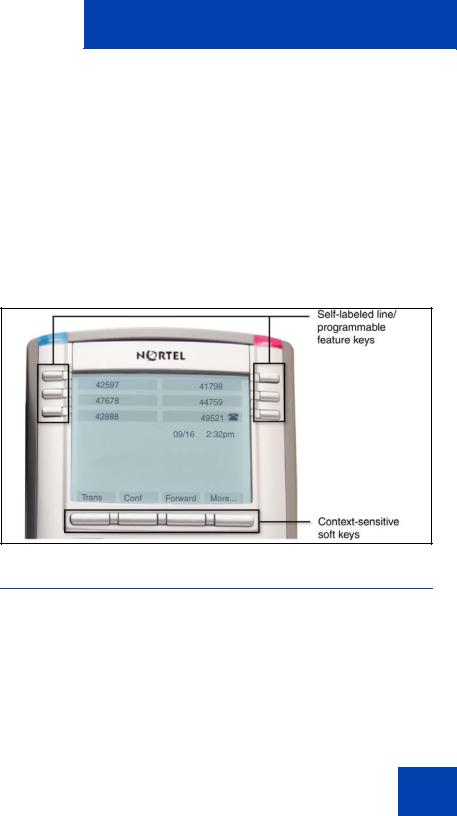
About the Nortel IP Phone 1140E
About the Nortel IP Phone 1140E
Your Nortel IP Phone 1140E brings voice and data to the desktop by connecting directly to a Local Area Network (LAN) through an Ethernet connection.
In this guide, self-labeled line/programmable feature key labels appear beside the keys, and context-sensitive soft key labels appear directly above the keys. Figure 1 shows self-labeled line/programmable feature keys and context-sensitive soft keys.
Figure 1: Self-labeled line/programmable feature keys and context-sensitive soft keys
Basic features
Your IP Phone 1140E supports the following features:
•six self-labeled line/programmable feature keys with labels and indicators
•four context-sensitive soft keys
For information about context-sensitive soft keys, see New in This Release Communication Server Release 5.0 (NN43001-115).
11

About the Nortel IP Phone 1140E
Note: Some IP Phone 1140E phones are not configured to support soft key functionality. Consult your system administrator.
•graphical, high-resolution LCD display, backlit, with adjustable contrast
•high-quality speaker phone
•volume control keys for adjusting ringer, speaker, handset, and headset volume
•six specialized feature keys:
—Quit
—Directory
—Message/Inbox
—Shift/Outbox
—Services
—Copy
•six call-processing fixed keys:
—Mute
—Handsfree
—Goodbye
—Expand
—Headset
—Hold
•gigabit Ethernet ports
•built-in gigabit Ethernet switch for shared PC access
•headset jack with an On/Off key
•USB port to support a keyboard, mouse, or wireless headset. Powered downstream 1.1-compliant USB hubs are supported, including USB 2.0 hubs, if they offer USB 1.1 backwards compliancy.
•automatic network configuration
•Graphical XAS
•hearing aid compatibility
12
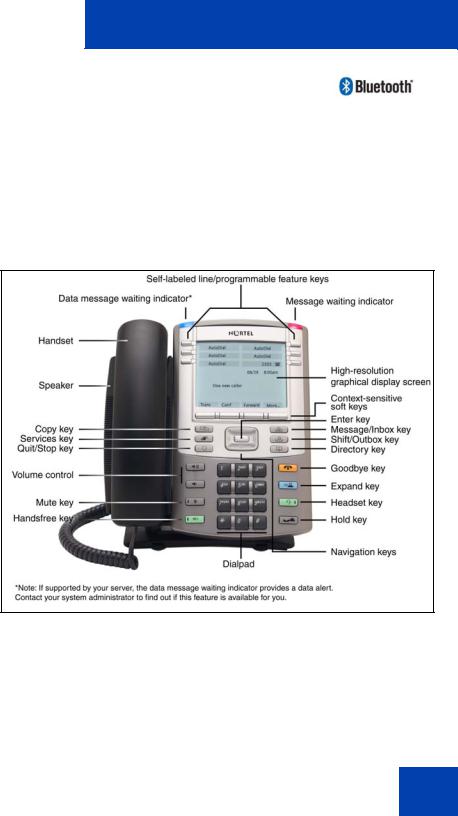
About the Nortel IP Phone 1140E
•wireless headset support using a Bluetooth® 1.2 wireless technology compliant Audio Gateway (Headset Profile, Bluetooth Power Class 2).
•Accessory Expansion Module port to connect the Expansion Module for IP Phone 1100 Series (Expansion Module)
For information about using the Expansion Module, see the Expansion Module for IP Phone 1100 Series User Guide (NN43130-101).
Figure 2 shows the IP Phone 1140E.
Figure 2: IP Phone 1140E
13
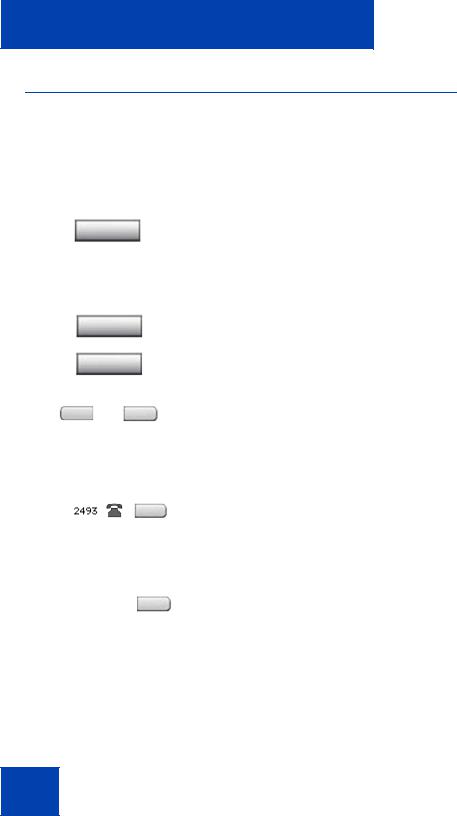
About the Nortel IP Phone 1140E
Telephone controls
This section describes the controls on your IP Phone 1140E. In some geographic regions, the IP Phone 1140E is offered with key caps that have English text labels. In this document, text in parentheses indicates the labels that appear on the key caps, for example, (Services).
Fwd |
Context-sensitive soft keys are located |
|
below the display area. The LCD label above |
|
each key changes based on the active |
|
feature. |
 Fwd
Fwd
More..
AutoAns Z
When a triangle appears before a soft key label, the feature is active.
Press the More key to access the next layer of context-sensitive soft keys (self-labeled).
The keys on either side of the LCD display area are self-labeled line/programmable feature keys, with labels on the LCD. These
keys also function as line (DN) keys.
A steady LCD light beside a line (DN) key indicates that the line is active. A flashing LCD light indicates the line is on hold or the feature is being programmed.
A steady LCD light beside a feature key indicates that the feature is active. A flashing LCD light indicates that the feature is being programmed.
14
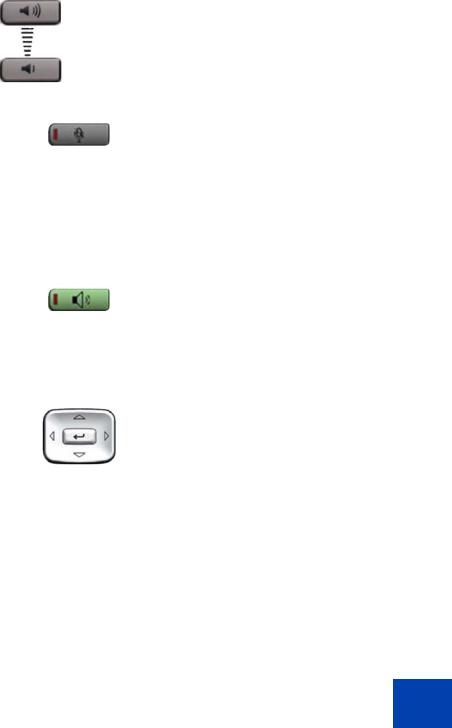
|
|
About the Nortel IP Phone 1140E |
|
|
|
|
|
(Volume +) |
Use the Volume control buttons to adjust |
|
|
|
|
the volume of the ringer, handset, headset, |
|
|
|
speaker, and the Handsfree feature. Press |
|
(Volume -) |
the top button to increase the volume, and |
|
|
press the bottom button to decrease the |
|
||
|
|
volume. |
|
|
|
Press the Mute key to listen to the receiving |
|
(Mute) |
party without transmitting. Press the Mute |
|
|
key again to return to two-way conversation. |
|
||
|
|
The Mute key applies to handsfree, handset, |
|
|
|
and headset microphones. |
|
|
|
The Mute LED indicator, located on the Mute |
|
|
|
key, flashes to indicate that the microphone |
|
|
|
is muted. |
|
|
|
Press the Handsfree key to activate |
|
(Handsfree) |
handsfree. |
|
|
The Handsfree LED indicator, located on the |
|
||
|
|
|
|
|
|
Handsfree key, lights to indicate when |
|
|
|
handsfree is active. |
|
|
|
Use the Navigation keys to scroll through |
|
|
|
menus and lists appearing on the LCD |
|
|
|
display screen. The outer part of this key |
|
|
|
cluster rocks for up, down, left, and right |
|
|
|
movements. |
|
|
|
Use Up and Down to scroll up and down in |
|
|
|
lists, and the Left and Right keys to position |
|
|
|
the cursor. In some dialog boxes that appear |
|
|
|
on your phone, you can also use the Left |
|
|
|
and Right keys to select editable fields; |
|
|
|
press the Right key to select the field below |
|
|
|
the current selection, or the Left key to |
|
|
|
select the one above. |
|
15
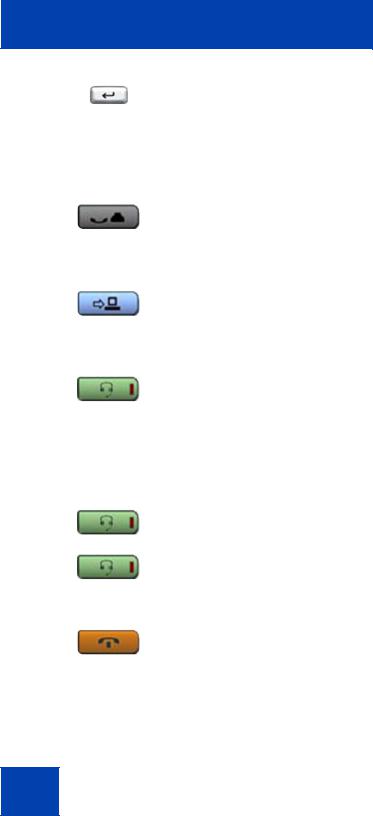
About the Nortel IP Phone 1140E
|
Use the Enter key, at the center of the |
|
|
Navigation key cluster, to confirm menu |
|
|
selections. |
|
|
In most menus, you can use the Enter key |
|
|
instead of the Select soft key. |
|
|
Press the Hold key to put an active call on |
|
|
hold. Tap the flashing line (DN) soft key to |
|
(Hold) |
return to the caller on hold. |
|
|
Use the Expand key to access external |
|
(Expand) |
server applications |
|
|
||
|
Press the Headset key to answer a call |
|
|
using the headset or to switch a call from the |
|
(Headset) |
handset or handsfree to the headset. |
|
|
The Headset LED indicator, located on the |
|
|
Headset key, lights to indicate that the |
|
|
headset is in use. |
|
|
Press the Headset key twice to open the |
|
(Headset) |
Bluetooth Setup menu. |
|
If Bluetooth wireless technology is not |
||
|
||
(Headset) |
enabled on your phone, this menu is not |
|
available. |
||
|
Use the Goodbye key to terminate an active |
|
(Goodbye) |
call. |
|
|
16
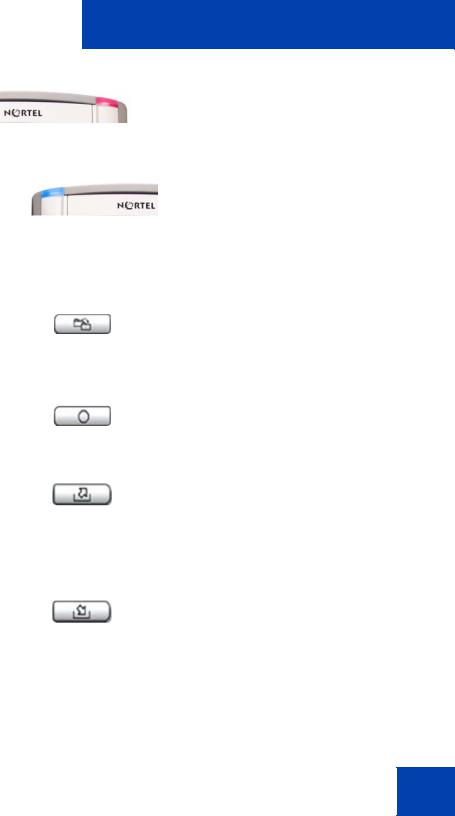
About the Nortel IP Phone 1140E
|
When a message is waiting, the red Visual |
|
|
Alerter/Message Waiting indicator lights. |
|
|
Also, when the ringer sounds, this indicator |
|
|
flashes. |
|
|
When your IP Phone 1140E firmware is |
|
|
being updated, the blue Feature Status |
|
|
Lamp indicator flashes. |
|
|
To find out if additional features are |
|
|
supported for this lamp, contact your |
|
|
administrator. |
|
|
Press the Copy Key to copy entries to your |
|
(Copy) |
Personal Directory from other lists, such as |
|
the Caller List, Redial List, and Corporate |
||
|
||
|
Directory. |
|
|
Press the Quit/Stop key to exit an active |
|
(Quit) |
menu or dialog. Pressing the Quit/Stop key |
|
does not affect the status of active calls. |
||
|
||
|
Press the Shift/Outbox key to toggle |
|
(Shift/Outbox) |
between two feature key pages and to |
|
access an additional six lines/features. |
||
|
||
|
This function is not available on all phones; |
|
|
consult your system administrator. |
|
|
Press the Message/Inbox key to access |
|
(Msg/Inbox) |
your voice mailbox. |
|
This function is not available on all phones; |
||
|
||
|
consult your system administrator. |
17

About the Nortel IP Phone 1140E
(Directory)
(Services)
Press the Directory key to access directory services.
Press the Services key and use the navigation keys to access the following items:
•Telephone Options:
—Volume adjustment
—Contrast adjustment
—Language
—Date/Time
—Display diagnostics
—Local Dialpad Tone
—Set Info
—Diagnostics
—Call Log Options
—Ring type
—Call Timer
—On hook default path
—Change Feature Key Label
—Name Display Format
—Live Dialpad
—Caller ID display order
—Normal mode indication
18

About the Nortel IP Phone 1140E
•Password Admin:
— Station Control Password
(Services)
(continued)
The Password Admin menu is not available on all IP Phone 1140E phones. Consult your system administrator.
•Display Network Diagnostics Utilities
Only your system administrator
or service provider can use Display Network Diagnostics Utilities to perform Internet diagnostics.
(Services)
(Services)
•Virtual Office Login and Virtual Office Logout (if Virtual Office is configured)
•Test Local Mode and Resume Local Mode (if Media Gateway 1000B is configured)
Press the Services key to exit from any menu or menu item.
Press the Services key twice to access the Local Tools menu, and use the navigation keys to access the following items:
•1. Preferences
•2. Local Diagnostics
•3. Network Configuration
•4. Lock Menu
If you attempt to access the Local Tools menu and a dialog box appears prompting you for a password, contact your system administrator. Your system administrator can establish a password for the Local Tools menu.
19
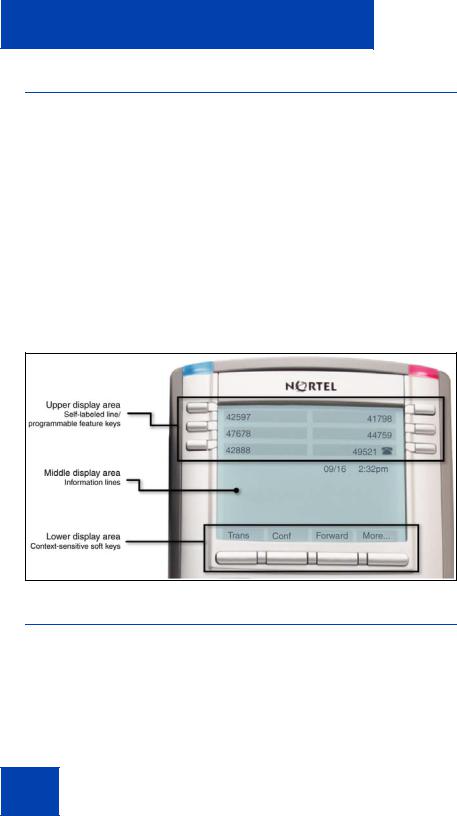
About the Nortel IP Phone 1140E
Telephone display
Your IP Phone 1140E has three display areas:
•The upper display area provides labels for the six self-labeled line/ programmable feature key labels.
•The middle display area contains single-line information for items such as caller number, caller name, Call Timer, feature prompt strings, user-entered digits, date and time information, and IP Phone information.
•The lower display area provides labels for the four context-sensitive soft keys.
Figure 3 shows an idle LCD screen.
Figure 3: IP Phone 1140E LCD screen
Call features and Flexible Feature Codes
Some features are not available on all IP Phones. Call features and Flexible Feature Codes (FFC) must be assigned to your IP Phone and supported by system software. Contact your system administrator to configure these features and codes on your IP Phone.
20

About the Nortel IP Phone 1140E
Security features
The following security features are available on your IP Phone 1140E:
•Using encrypted calling
•Managing your Station Control Password (SCPW)
Using encrypted calling
Your IP Phone 1140E supports secure communication using SRTP media encryption. If the feature is enabled, a security icon (q) appears on the screen when your call is secured using SRTP media encryption. Contact your system administrator to find out if this feature is available for your use.
Managing your Station Control Password (SCPW)
Your Station Control Password (SCPW) enables the following security features:
•Electronic Lock to prevent others from making calls from your IP Phone
•password-protected IP Phone features (for example, Personal Directory, Redial List, and Callers List)
Your system administrator defines your initial SCPW. Contact your system administrator for detailed information.
To change your SCPW:
1. Press the Services key.
(Services)
2.Press the Up/Down keys to scroll and highlight Password Admin.
21

About the Nortel IP Phone 1140E
|
3. |
Press the Enter key. |
|
4. |
Use the dialpad to enter your password |
|
|
at the prompt. |
|
5. |
Press the Up/Down keys to scroll and |
|
|
highlight New Password. |
|
6. |
Press the Enter key. |
|
7. |
Use the dialpad to enter the new |
|
|
password. |
Select |
8. |
Press the Select soft key to accept the |
|
|
new password. |
If you are locked out of your
IP Phone 1140E, or if you forget your SCPW, contact your system administrator.
Note: The default configuration for Password Protection is off.
To turn Password Protection on or off:
1. Press the Directory key.
(Directory)
22
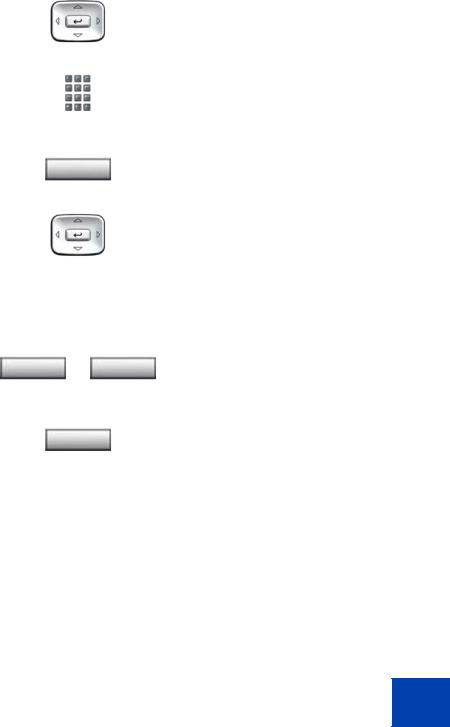
|
|
|
|
About the Nortel IP Phone 1140E |
|
|
|
|
|
|
|
|
|
2. |
Press the Up/Down navigation keys to |
|
|
|
|
|
scroll and highlight Change Protection |
|
|
|
|
|
Mode. |
|
|
|
|
3. |
Use the dialpad to enter your password |
|
|
|
|
|
(if Password Protection is enabled). |
|
|
Enter |
4. |
Press the Enter soft key. |
|
||
|
|
5. |
Press the Up/Down navigation keys to |
|
|
|
|
|
scroll and highlight one of the following: |
|
|
|
|
|
— |
Enable Password Protection |
|
|
|
|
— |
Disable Password Protection |
|
|
|
6. |
Choose one of the following soft keys: |
|
|
Yes |
No |
— |
Yes to accept the selection |
|
|
or |
|
— No to return to the Directory menu |
|
||
|
|
|
|
||
Done |
7. |
Press the Done soft key. |
|
||
23

Entering and editing text
Entering and editing text
You can enter and edit text on your IP Phone 1140E using the following methods:
•“Entering text using the IP phone dialpad” on page 24
•“Entering text using the USB keyboard” on page 25
•“Editing text using the soft keys” on page 25
The use of any of these methods for text entry or editing depends on the application. Table 1 shows the applications and input devices that you can use for text entry.
Table 1: Application text entry
For: |
Use: |
|
|
|
|
Call Server-related applications |
Dialpad |
|
(for example, changing feature |
USB keyboard for numeric |
|
key labels, adding personal |
||
entries only |
||
directory entries, or dialing) |
||
|
||
|
|
|
Graphical applications |
USB keyboard |
|
|
|
|
Local Tools menu |
USB keyboard |
|
|
Dialpad for numeric entries |
|
|
|
Entering text using the IP phone dialpad
You can use the dialpad to enter text when you use features such as Personal Directory, Redial List, and Callers List. Use the dialpad in conjunction with the soft keys.
For example, if you want to enter the letter A, press the number 2 key once. If you want to enter the letter C, press the number 2 key three times. No letters are associated with the number 1 or the 0 keys.
24

Entering and editing text
Entering text using the USB keyboard
You can use the USB keyboard, when connected, to enter text in the tools and graphical applications.
For number entry in phone applications (for example, when dialing), you can use the keyboard to enter digits (0–9), as well as * and #. Other characters are ignored.
When on a call, you can use the function keys (f1, f2, f3, f4, f5, f6, f7, and f8) to control the IP Phone. Table 2 shows the function keys and their associated action during IP Phone calls.
Table 2: USB keyboard function keys during IP Phone calls
Function key |
Action |
|
|
f1 |
Go to Handsfree mode |
|
|
f2 |
Go to Headset mode |
|
|
f3 |
Place the current call on hold |
|
|
f4 |
Mute the current call |
|
|
f5 |
Volume up |
|
|
f6 |
Volume down |
|
|
f7 |
Copy |
|
|
f8 |
Quit |
|
|
Editing text using the soft keys
You can use soft keys to edit text when you use features such as Personal Directory, Redial List, and Callers List. Use the soft keys in conjunction with the dialpad.
25

Entering and editing text
To edit an entry in your Personal Directory, press the Directory key, and select the desired entry from your Personal Directory.
To edit text with the soft keys:
1.Press the Edit soft key.
2.Press the Left/Right navigation keys to move through the text.
3.Select the appropriate editing soft key for the operation you want to perform.
4.If the character you want is not visible, press the More soft key to access the next layer of soft keys.
5.To add non-alphanumeric symbols, press the Symbol soft key, and perform the following:
a.Press the Up navigation key to access the symbols.
b.Press the Left/Right navigation keys to move to a specific symbol.
c.Press the Choose soft key to select a symbol.
6.Press the Next soft key to submit your changes.
When you are editing text using the soft keys, various commands are available on the soft keys to help you, as described in Table 3.
Table 3: Editing soft key description
Soft key |
Description |
|
|
Cancel |
Cancel an action. |
|
|
Choose |
Select a non-alphanumeric symbol (available |
|
only after the Symbol soft key is selected). |
|
|
Clear |
Clear the input field. |
|
|
Case |
Switch the next character to either uppercase or |
|
lowercase. |
|
|
Delete |
Backspace one character. |
|
|
Done/Select/Enter |
Varies, depending on the state of your phone. |
|
|
More |
Access additional soft keys. |
|
|
26
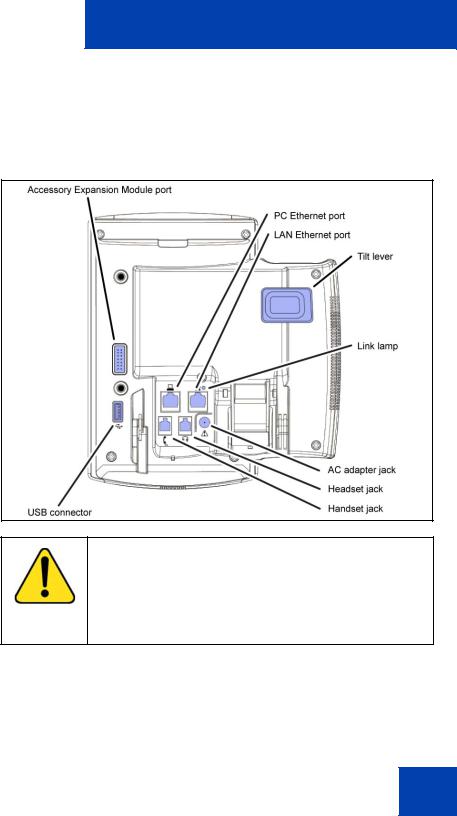
Connecting the components
Connecting the components
Figure 4 shows connections on the IP Phone 1140E.
Figure 4: IP Phone 1140E connections
WARNING
Ensure that the protective rubber cap on the Accessory Expansion Module port is in place when the port is not in use. Connecting anything other than the proper Expansion Module for IP Phone 1100 Series connector to this port can cause damage to the IP Phone.
27
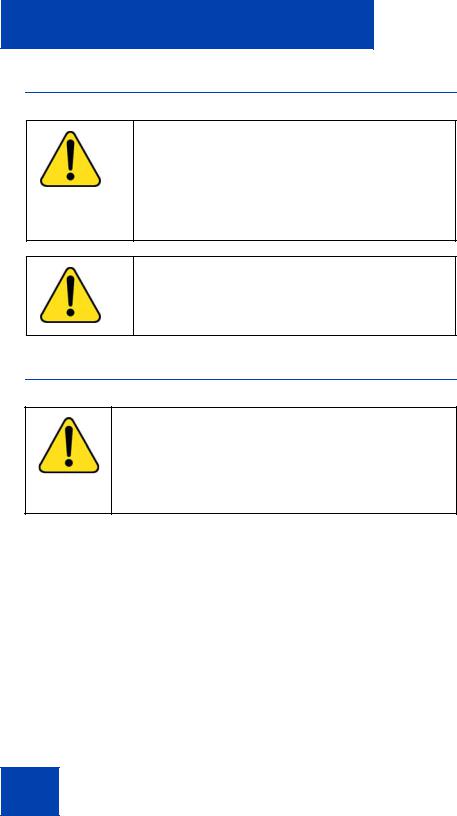
Connecting the components
Before you begin
CAUTION
Damage to Equipment
Do not plug your IP Phone 1140E into a regular phone jack. This results in severe damage to the IP Phone. Consult your system administrator to ensure that you plug your IP Phone into a 10/ 100BaseT Ethernet jack.
CAUTION
Your IP Phone 1140E is designed for use in an indoor environment only.
Connecting the components of the phone
WARNING
Your IP Phone 1140E is shipped with the base locked in position. To avoid damaging your phone, press the wallmount lever, located just under the Handsfree key as indicated in Figure 5 on page 29, to release the base and pull it away from the phone.
28
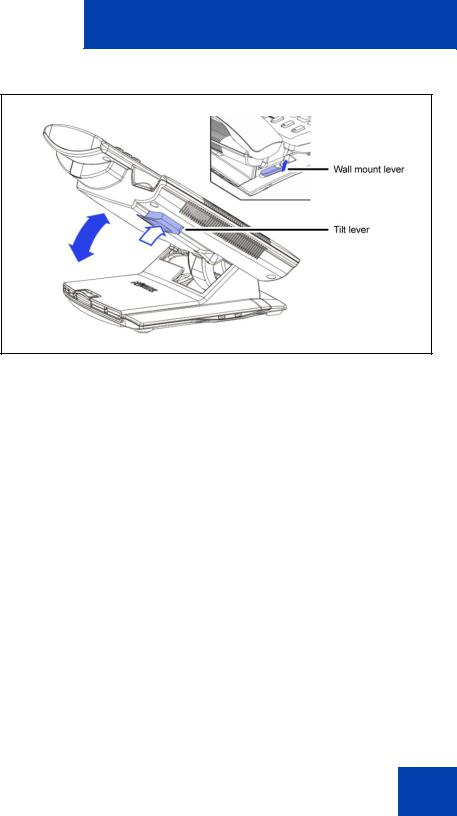
Connecting the components
Figure 5: Release the IP Phone 1140E from the stand
Use the following steps to connect the components of your phone.
1.Remove the stand cover. Pull upward on the center catch as indicated in Figure 6 on page 30, and remove the stand cover. The cable routing tracks are now accessible.
29
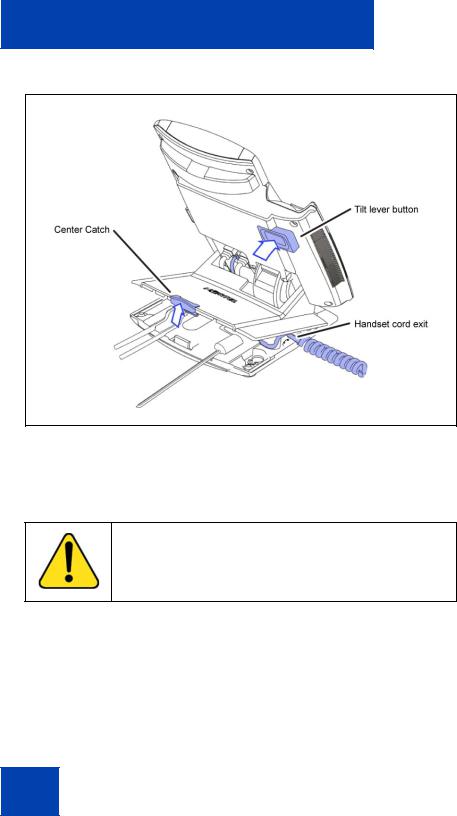
Connecting the components
Figure 6: Remove the stand cover
2.Connect the AC power adapter (optional). Connect the adapter to the AC adapter jack in the bottom of the phone. Form a small bend in the cable, and then thread the adapter cord through the channels in the stand.
WARNING
Use your IP Phone 1140E with the approved Nortel AC Adapter (model #N0089601).
Note 1: Your IP Phone 1140E supports both AC power and Power over Ethernet options, including IEEE 802.3af standard power. To use local AC power, the optional AC adapter can be ordered separately. To use Power over Ethernet, where power is delivered
30
